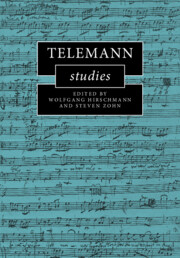Book contents
- Telemann Studies
- Cambridge Composer Studies
- Telemann Studies
- Copyright page
- Contents
- Figures
- Music Examples
- Tables
- Appendices
- Contributors
- Preface
- Abbreviations
- Part I Enlightenment Perspectives
- Part II Urban and Courtly Contexts
- Part III Nature (and) Theology in the Late Vocal Works
- 7 Telemann’s Donner-Ode and Lutheran Nature Theology
- 8 Body, Nature, and Emotion in Telemann’s Christmas Cantatas
- 9 Beyond Simplicity
- Part IV Bach Family Connections
- Part V Cantata Cycles in Frankfurt, Hamburg, and Beyond
- Index of Telemann’s Works
- General Index
9 - Beyond Simplicity
Telemann’s Musical Idyll Der May, TVWV 20:40
from Part III - Nature (and) Theology in the Late Vocal Works
Published online by Cambridge University Press: 14 July 2022
- Telemann Studies
- Cambridge Composer Studies
- Telemann Studies
- Copyright page
- Contents
- Figures
- Music Examples
- Tables
- Appendices
- Contributors
- Preface
- Abbreviations
- Part I Enlightenment Perspectives
- Part II Urban and Courtly Contexts
- Part III Nature (and) Theology in the Late Vocal Works
- 7 Telemann’s Donner-Ode and Lutheran Nature Theology
- 8 Body, Nature, and Emotion in Telemann’s Christmas Cantatas
- 9 Beyond Simplicity
- Part IV Bach Family Connections
- Part V Cantata Cycles in Frankfurt, Hamburg, and Beyond
- Index of Telemann’s Works
- General Index
Summary
In terms of artifice, Telemann’s “musical idyll” Der May (ca. 1760), to a text by Karl Wilhelm Ramler, ranks far behind the composer’s other works from this time. Most aspects of the music are entirely regular, and they are embedded in harmonic progressions that hardly exceed simple cadential relations. In this sense, Der May reflects aesthetic discussions among German writers in the 1750s and 1760s about widely disseminated and translated poetry such as Salomon Gessner’s “Idyllen” of 1756. Among contemporary theorists, Johann Abraham Sulzer and Johann Christoph Gottsched describe the distance separating literary idylls and social reality as one of the genre’s constitutive features. Idylls can thus serve as a tool of self-assurance in an increasingly complex modernity where acceleration, secularization, and scientification lead to a widely experienced dichotomy between complexity and simplicity. In applying the concept of “othering” to analyze the multiple modernities of the 1760s, I ask whether Telemann’s Der May can be regarded as an alternative to the modernity of its time; that is, as a conceptually “postmodern” work.
- Type
- Chapter
- Information
- Telemann Studies , pp. 199 - 212Publisher: Cambridge University PressPrint publication year: 2022

